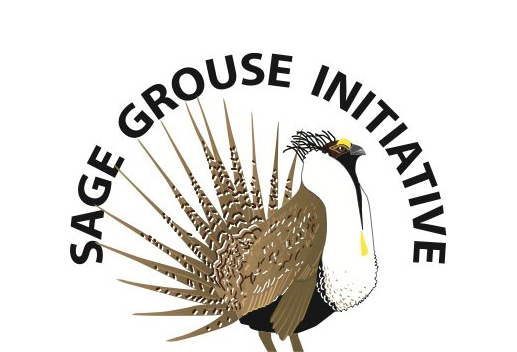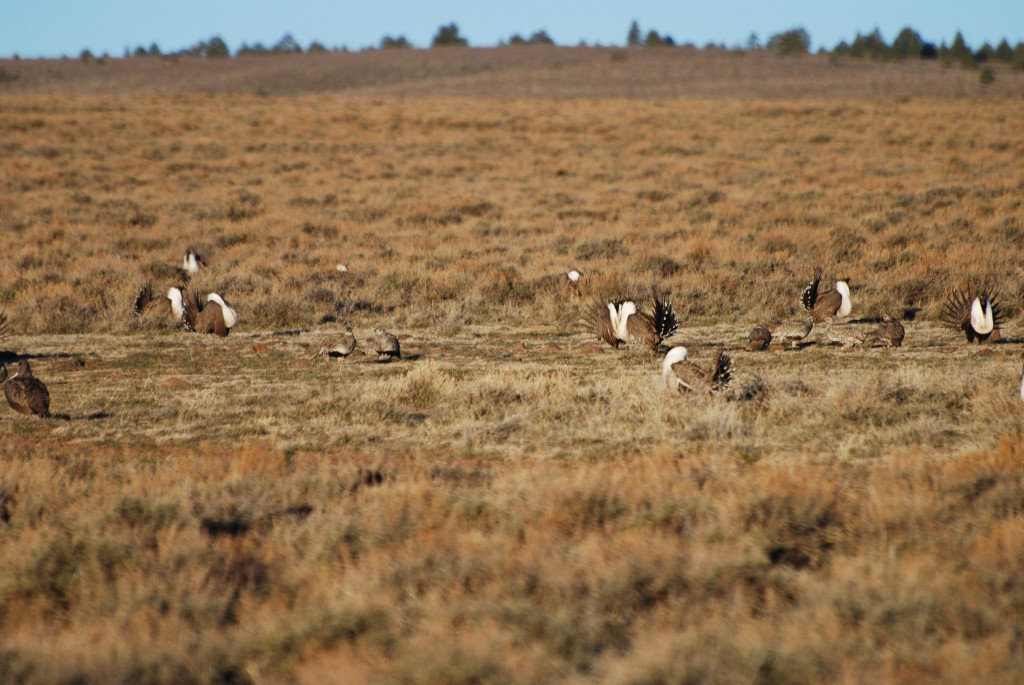Sage Grouse Populations Grow When Conifers are Removed


NEW RESEARCH SHOWS SAGE GROUSE POPULATIONS GROW 12% WHEN CONIFERS ARE REMOVED
In the last two centuries, woody plants have been expanding into the world’s vast grasslands and shrub-steppe rangelands. In the U.S., the expansion of conifers into the Great Plains and sagebrush-steppe has created a cascade of effects that include altered water regimes, habitat loss, increased fire severity, and more. In the last two decades, land managers, both public and private, have begun to understand the scope of this problem, pinpoint effective management solutions, and implement those solutions. These efforts have given scientists the chance to study how wildlife like sage grouse respond to conifer reduction efforts.
Andrew Olsen is one of these scientists; he has spent the last several years studying how sage grouse populations responded to sustained conifer removal efforts near the Warner Mountains in south central Oregon. Olsen’s research offers fresh insights into the outcomes produced by conifer removal.
Read more about conifer encroachment in sagebrush landscapes.
Why is this phenomenon happening now? What is allowing conifer trees to move into open grasslands and shrub-steppe rangelands and how is this impacting sage grouse?
Changes in land use patterns and subsequent alterations to historic fire regimes are the primary drivers of conifer expansion. Historically, fire limited the spread of conifers and periodically pushed them back to areas that don’t burn as well like higher elevation zones and rocky areas with limited grass cover. Humans impacted natural fire cycles beginning in the mid 1800s. At upper elevations, fires have become less frequent allowing conifer woodlands to become denser and expand into previously treeless shrublands. At lower elevations, invasive annual grasses like cheatgrass have established, resulting in fires that are now too frequent. These altered fire regimes in prime sagebrush country are squeezing sage grouse into smaller areas of suitable habitat – trees are pushing sage grouse out of previously healthy mid- and high-elevation sagebrush and cheatgrass is pushing sage grouse out of lower-elevation sagebrush.

Are the woody plants that are invading shrub-steppe and grassland ecosystems exotic invaders like cheatgrass, knapweed, or kudzu?
No, the conifers that are expanding into shrub-steppe and grassland ecosystems are native species like western juniper and pinyon pine. However, they are out of balance and growing in areas where they haven’t been present historically. The expansions have characteristics and consequences that are often indistinguishable from exotic invasions, making it an interesting management challenge.
Aren’t more trees generally a good thing? Why is this considered a problem?
Healthy sagebrush-steppe habitat is characterized by expansive, intact sagebrush cover, that’s why it’s often called the “sagebrush sea”. Sage grouse and other sagebrush-loving wildlife need wide open, treeless landscapes. The expansion of conifers into sagebrush-steppe fragments these open vistas and reduces the quality of habitat for these species.
How big of a problem is it?
As much as 90% of the sagebrush-steppe and Great Basin sagebrush landscapes currently dominated by conifers were predominantly treeless sagebrush ecosystems prior to the late 1800s.
What are some of the negative effects conifers have on sage grouse specifically?
Sage grouse avoid areas where there are as few as one or two conifers per acre, even when the sagebrush understory is intact and dominant. Conifers provide more perch sites for avian predators such as golden eagles that prey on adults and ravens that prey on eggs. Previous research has shown that even though sage grouse move more quickly through areas where conifers are present, they also suffer increased mortality in those areas. Removing conifers in targeted areas reduces depredation.
Your research focused on what happened to sage grouse populations after juniper trees are removed from an area. How was your approach different from other studies?
Two key components have helped to make my study unique and powerful. First, I was able to work at a watershed scale: Sage grouse were marked with transmitters and monitored at a 109,000-acre “treatment” site where trees were cut and an 82,000-acre “control” site where trees were not removed. Second, this study occurred over an eight-year period. That length is nearly unheard of in sage grouse research. Without consistent support from the USDA-NRCS and the BLM, I couldn’t have run my study for as long as I did. The extended time frame allowed me to measure the effects of conifer removal over many years, which hadn’t been done before. Research that occurs over such a large area and over such a long time gives us really strong data when assessing the response of sage grouse to conifer removal.

What does your research find?
I found that after five or six years of cutting conifers, sage grouse population growth rates were 12% higher where conifers were cut relative to where no conifers were cut. For a long-lived game bird like the sage grouse, this is a tremendous difference and indicates that conifer removal increases sage grouse populations. The increase in population growth rates was driven by increases in juvenile, adult, and nest survival. This indicates that conifer removal benefits several important sage grouse life stages. Many studies have shown how we can reduce sage grouse population declines through practices like conservation easements that prevent habitat fragmentation. However, this is the first study showing that we can increase sage grouse populations through targeted and sustained habitat restoration through conifer removal.

Were you surprised to find such a strong sage grouse population improvement following conifer removal?
Previous work at my study site indicated that conifer removal increased adult and nest survival, so I expected to see some sort of population response. However, I was surprised by the clear pattern and steady increase in population growth rates where we removed trees versus where we didn’t. I was also surprised to see such a large difference in growth rates after only five to six years of conifer removal. Sage grouse populations typically fluctuate year to year, but the length of this study allowed me to detect the increases in population growth rates despite this natural variation.
What should land managers and conservation partnerships like the Sage Grouse Initiative learn from your research?
I think there are two key takeaways from my research: 1) conifer removal is an effective tool for increasing sage grouse populations, and 2) sage grouse populations may take several years to respond to management actions because they are long lived and have lower reproductive output compared to other game birds. I would encourage careful targeting of areas to remove expanding conifers and applaud SGI for grouping these efforts to achieve watershed-scale sagebrush restoration.
Meet the Expert
You’ve spent a lot of time and energy working on this over the years. What drew you to this project in particular?
As a native of Montana, I spent much of my childhood recreating in sage grouse country and
grew to love the landscapes and wildlife of the sagebrush-steppe. I pursued this project because the science I was producing would inform wildlife and habitat management. That was important to me. Also, Oregon State University has an outstanding Fisheries and Wildlife Department!
After all this time watching and studying sage grouse, what surprises you the most about the bird?
I often marvel at their toughness and resilience. For example, they survive the brutal, high-desert winters eating nothing but sagebrush, and in the summer, hens will walk their chicks miles and miles to find water. This bird is perfectly adapted to intact, functional sagebrush-steppe and my research indicates that their populations can respond positively to targeted habitat management.
What’s next for you and your research?
I am continuing my work at Oregon State University under Dr. Christian Hagen, focusing on sharing this study with conservation professionals and producers working in sagebrush country. I love what I do and am excited to continue to research and contribute to sage grouse conservation and management!
SHARE ON
You may also like
The role corn plays for gamebirds and economies ac...
Sportsmen’s conservation policy issues from publ...
Sportsmen’s conservation policy issues from publ...


























